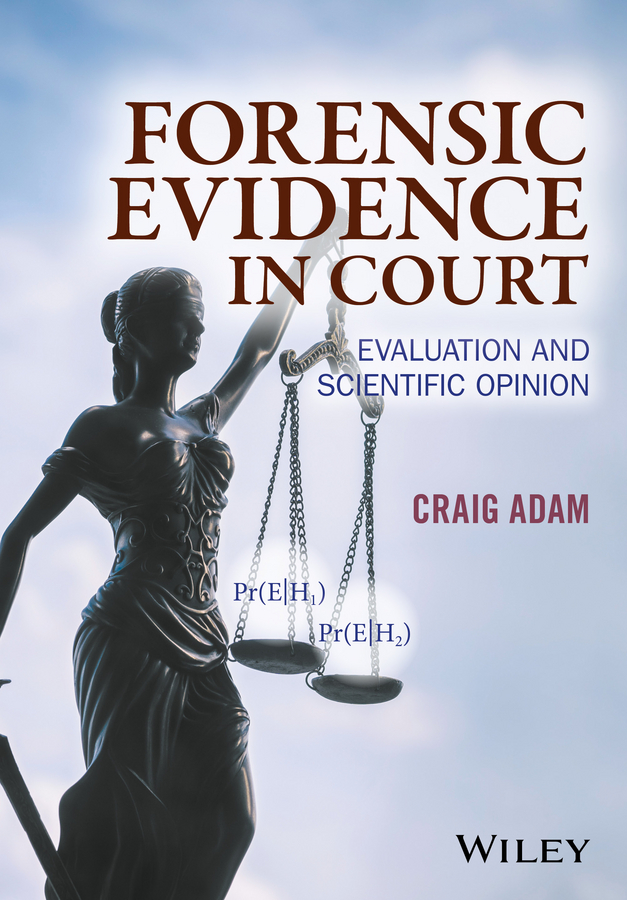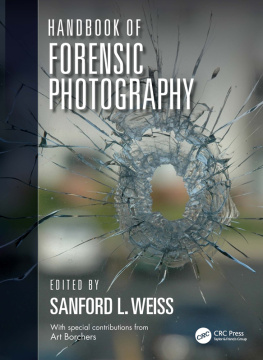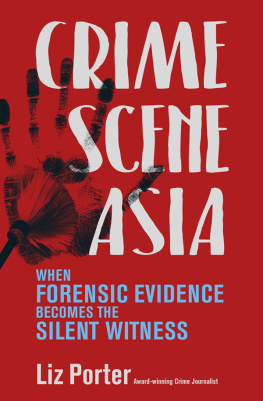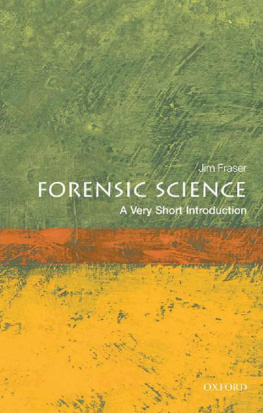
Table of Contents
List of Tables
- Chapter 07
- Chapter 12
- Chapter 13
- Chapter 17
- Chapter 19
List of Illustrations
- Chapter 02
Guide
Pages
Forensic Evidence in Court
Evaluation and Scientific Opinion
CRAIG ADAM
This edition first published 2016
2016 John Wiley & Sons, Ltd
Registered office
John Wiley & Sons, Ltd, The Atrium, Southern Gate, Chichester, West Sussex, PO19 8SQ, United Kingdom
For details of our global editorial offices, for customer services and for information about how to apply for permission to reuse the copyright material in this book please see our website at www.wiley.com.
The right of the author to be identified as the author of this work has been asserted in accordance with the Copyright, Designs and Patents Act 1988.
All rights reserved. No part of this publication may be reproduced, stored in a retrieval system, or transmitted, in any form or by any means, electronic, mechanical, photocopying, recording or otherwise, except as permitted by the UK Copyright, Designs and Patents Act 1988, without the prior permission of the publisher.
Wiley also publishes its books in a variety of electronic formats. Some content that appears in print may not be available in electronic books.
Designations used by companies to distinguish their products are often claimed as trademarks. All brand names and product names used in this book are trade names, service marks, trademarks or registered trademarks of their respective owners. The publisher is not associated with any product or vendor mentioned in this book.
Limit of Liability/Disclaimer of Warranty: While the publisher and author have used their best efforts in preparing this book, they make no representations or warranties with respect to the accuracy or completeness of the contents of this book and specifically disclaim any implied warranties of merchantability or fitness for a particular purpose. It is sold on the understanding that the publisher is not engaged in rendering professional services and neither the publisher nor the author shall be liable for damages arising herefrom. If professional advice or other expert assistance is required, the services of a competent professional should be sought.
Library of Congress CataloginginPublication Data
Names: Adam, Craig.
Title: Forensic evidence in court: evaluation and scientific opinion / Craig Adam.
Description: United Kingdom : John Wiley & Sons, 2016. | Includes bibliographical references and index.
Identifiers: LCCN 2016012014 (print) | LCCN 2016012473 (ebook) | ISBN 9781119054412 (cloth) | ISBN 9781119054429 (pdf) | ISBN 9781119054436 (epub)
Subjects: LCSH: Evidence, ExpertMethodology. | Forensic sciences. | Evidence, ExpertHistory.
Classification: LCC K2283 .A935 2016 (print) | LCC K2283 (ebook) | DDC 347.73/67dc23
LC record available at https://lccn.loc.gov/2016012014
A catalogue record for this book is available from the British Library.
Preface
This book is about how science and scientific opinion impinge upon and influence legal debate. It is written by a scientist, principally for an audience of scientists, more specifically for those in the later stages of an undergraduate degree in forensic science, studying at postgraduate level or working as practitioners. As such, a basic understanding of the discipline and of technical matters relating to evidence examination and analysis is assumed, although relevant science is recapped and expanded upon where appropriate. The context throughout is the court of law. Legal cases from across jurisdictions, including principally those based on the AngloAmerican legal system, are used to demonstrate the evolution of expert opinion, to illustrate the difficulties faced by the scientists and the legal professionals and to provide a real world backdrop to material intended for exposition and discussion in the lecture room.
Although this book is an educational text and not a research monograph, this field of study is subject to developments and advances from both the professional and academic spheres. It is relevant therefore to include some discussion of the scholarship that underpins professional practice and, more specifically, I have incorporated recent research that seeks to resolve current difficulties and may impact directly on expert testimony in the future.
To meet the aims of this text the material is organised within three sections. The first serves the dual purpose of setting the scene, by reviewing the impact of forensic science in the courts over the past thirty years, as well as providing the overall context within which methods for interpretation and evaluation of scientific evidence have been and continue to be developed. This is followed by five chapters in which the focus centres on the forensic scientist as expert witness and ways in which scientific opinion may be formulated from the interpretation of experimental findings, particularly through logical evaluation by likelihood ratio; this includes discussion of many of the issues around the delivery of such opinion.
The final section presents scientific opinion in the context of evidence types. Starting from full DNA profiles where quantitative approaches are informed by rigorously derived databases, the discussion moves to other types of evidence such as footwear marks, glass and fibres where the interpretation may be more qualitative and the associated databases more open to challenge. Later chapters deal with evidence such as handwriting and bloodstain pattern analysis where opinion is formulated much more in accordance with the experience of the individual expert and indeed where the members of the court may believe they can achieve their own evaluation by reviewing the evidence for themselves.
I am very grateful to Dr Ian Evett CBE and Mr Mike Allen for reading and commenting on draft sections of this text. I trust that I have been able to use their feedback to improve the accuracy and clarity of the discussion but the final responsibility for that, of course, must rest with me. I also wish to thank my wife, Alison, for her invaluable advice, patience and support throughout the development and writing of this book.
Craig Adam,
January 2016
Part 1
An Introduction to the Admissibility of Expert Scientific Opinion
1.1 Admissibility, Reliability and Scientific Evidence
The investigative and legal processes, from the discovery of a crime to the verdict of the court, should ultimately ensure that the guilty person is correctly identified and that the innocent are exonerated. However, in many cases, the complexity, both of these processes and of the contributions to the debate, may lead to difficulties and challenges that act to impede and divert both scientific and legal arguments and which may lead to an unsatisfactory outcome. This book is concerned principally with the contribution of scientific evidence to legal debate. Central to this is an understanding of how the scientists findings can be properly interpreted, evaluated and communicated to the court and how the court draws appropriate inferences from the expert opinion in reaching its decision on the ultimate issue. In doing so, the court must necessarily be satisfied that the science is valid and the evidence relevant to its deliberations.
Next page






